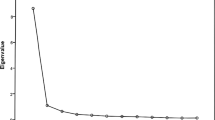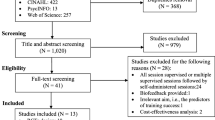Abstract
Introduction and hypothesis
Pelvic floor muscle training (PFMT) is the recommended first-line treatment for women with urinary incontinence (UI). Success rates are variable and dependent on a number of factors. The development of an incontinence treatment motivation questionnaire (ITMQ) provides us with a tool to assess patient self-motivation with respect to PFMT and UI. The aim of this study was to determine the effect of women’s self-motivation to perform PFMT on outcome.
Methods
Women with stress predominant UI completed an ITMQ and a 24-h pad test and then underwent a 12-week course of supervised PFMT. At the end of their treatment they completed a patient global impression of improvement questionnaire (PGI-I) and a second 24-h pad test. The PGI-I scores and the difference in pad test weight correlated with the ITMQ according to Spearman’s correlation coefficient.
Results
Sixty-five women were recruited. Thirty-two (49 %) patients perceived themselves as having improved, 28 women (43 %) did not experience any change in symptoms and 5 women (8 %) felt that their symptoms deteriorated following treatment. When correlating the PGI-I with the ITMQ, 3 of the 5 domains: MQS1 (positive attitude for treatment; p = 0.003), MQS3 (frustration of living with incontinence; p = 0.002) and MQS4 (desire for treatment; p = 0.002) correlated significantly with outcome. Desire for treatment was the only domain to correlate with change in pad weight (p = 0.001).
Conclusion
Self-motivation is essential in order to determine improved success rates with PFMT.


Similar content being viewed by others
References
Haylen BT, de Ridder D, Freeman RM, Swift SE, Berghmans B, Lee J, Monga A, Petri E, Rizk DE, Sand PK, Schaer GN (2010) An International Urogynecological Association (IUGA)/International Continence Society (ICS) joint report on the terminology for female pelvic floor dysfunction. Int Urogynecol J 21(1):5–26. Review
Kelleher CJ, Cardozo LD, Khullar V, Salvatore S (1997) A new questionnaire to assess the quality of life of urinary incontinent women. Br J Obstet Gynaecol 104:1374–1379
Dumoulin C, Hay-Smith J (2010) Pelvic floor muscle training versus no treatment, or inactive control treatments, for urinary incontinence in women. Cochrane Database Syst Rev. 20(1):
National Institute of Clinical Excellence (2009) Guidelines on urinary incontinence
Kondo A, Yamada Y, Morishige R, Niijima R (1996) An intensive programme for pelvic floor muscle exercises: short- and long-term effects on those with stress urinary incontinence. Hinyokika Kiyo 42:853–859
Mørkved S, Bø K, Fjørtoft T (2002) Effect of adding biofeedback to pelvic floor muscle training to treat urodynamic stress incontinence. Obstet Gynecol 100:730–739
Moore KH, O’Sullivan RJ, Simons A, Prashar S, Anderson P, Louey M (2003) Randomised controlled trial of nurse continence advisor therapy compared with standard urogynaecology regimen for conservative incontinence treatment: efficacy, costs and two year follow up. BJOG 110:649–657
Sarma S, Hawthorne G, Thakkar K, Hayes W, Moore KH (2009) The development of an incontinence treatment motivation questionnaire for patients undergoingpelvic floor physiotherapy in the treatment of stress incontinence. Int Urogynecol J Pelvic Floor Dysfunct 20:1085–1093
Bronken BA, Kirkevold M, Martinsen R, Wyller TB, Kvigne K (2012) Psychosocial well-being in persons with aphasia participating in a nursing intervention after stroke. Nurs Res Pract 568242
Miller JM, Sampselle C, Ashton-Miller J, Hong GR, DeLancey JO (2008) Clarification and confirmation of the Knack maneuver: the effect of volitional pelvic floor muscle contraction to preempt expected stress incontinence. Int Urogynecol J Pelvic Floor Dysfunct 19(6):773–782
Yalcin I, Bump R (2003) Validation of two global impression questionnaires for incontinence. Am J Obstet Gynecol 189:98–101
Slack A, Hill A, Jackson S (2007) Is there a role for a specialist physiotherapist in the multidisciplinary management of women with stress incontinence referred from primary care to a specialist continence clinic? J Obstet Gynaecol 28:410–412
Zanetti MR, Castro Rde A, Rotta AL, Santos PD, Sartori M, Girao MJ (2007) Impact of supervised physiotherapeutic pelvic floor exercise for treating female stress urinary incontinence. Sao Paulo Med J 6(125):265–269
Tsai YC, Liu CH (2009) The effectiveness of pelvic floor exercises, digital vaginal palpation and interpersonal support on stress urinary incontinence: an experimental study. Int J Nurs Stud 46:1181–1186
Williams KS, Assassa RP, Gillies CL, Abrams KR, Turner DA, Shaw C, Haslam J, Mayne C, McGrother CW (2006) Leicestershire MRC incontinence study team. A randomized control trial of the effectiveness of pelvic floor therapies for urodynamic stress and mixed incontinence. BJU Int 98:1043–1050
Castro RA, Aruda RM, Zanetti MR, Santos PD, Sartori MG, Girao MJ (2008) Single-blind, randomized controlled trial of pelvic floor muscle training, electrical stimulation, vaginal cones, and no active treatment in the management of stress urinary incontinence. Clinics (Sao-Paulo) 63:465–472
Kusurkar RA, Croiset G, Mann KV, Custers E, Ten Cate O (2012) Have motivation theories guided the development and reform of medical education curricula? A review of the literature. Acad Med 87(6):735–743. Review
Fromer L (2011) Implementing chronic care for COPD: planned visits, care coordination, and patient empowerment for improved outcomes. Int J Chron Obstruct Pulmon Dis 6:605–614. Review
Ogedegbe G, Schoenthaler A, Richardson T, Lewis L, Belue R, Espinosa E, Spencer J, Allegrante JP, Charlson ME (2007) An RCT of the effect of motivational interviewing on medication adherence in hypertensive African Americans: rationale and design. Contemp Clin Trials 28:169–181
Cockle-Hearne J, Faithfull S (2010) Self-management for men surviving prostate cancer: a review of behavioural and psychosocial interventions to understand what strategies can work, for whom and in what circumstances. Psychooncology 19:909–922. Review
Huffman M (2007) Health coaching: a new and exciting technique to enhance patient self-management and improve outcomes. Home Health Nurse 25:271–274, quiz 275–276
Aujoulat I, d’Hoore W, Deccache A (2007) Patient empowerment in theory and practice: polsemy or cacophony. Patient Educ Couns 66:13–20
Jerant A, Moore M, Loring K, Franks P (2008) Perceived control moderated the self-efficacy enhancing effects of a chronic illness self-management intervention. Chronic Illn 4:173–182
Franks P, Chapman B, Deberstein P, Jerant A (2009) Five factor model personality factors moderated the effects of an intervention to enhance chronic disease management self-efficacy. Br J Health Psychol 14:473–487
Funding
No external funding was obtained.
Conflicts of interest
The authors report no conflicts of interest concerning this study.
Ethical approval
Kent Research Ethics Committee UK. REC no. 10/H1101/65
Author information
Authors and Affiliations
Corresponding author
Rights and permissions
About this article
Cite this article
Vella, M., Nellist, E., Cardozo, L. et al. Does self-motivation improve success rates of pelvic floor muscle training in women with urinary incontinence in a secondary care setting?. Int Urogynecol J 24, 1947–1951 (2013). https://doi.org/10.1007/s00192-013-2115-x
Received:
Accepted:
Published:
Issue Date:
DOI: https://doi.org/10.1007/s00192-013-2115-x




